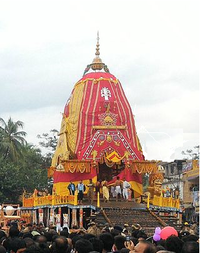The Ratha Yatra, also known as the Festival of Chariots, is a revered and accidental Hindu festival celebrated at the Shree Jagannatha Temple in Puri, Odisha. This grand event is a testament to the rich cultural heritage of India and is deeply rooted in the traditions and legends of the region. The festival is observed annually, typically on the second day of the region. The festival is observed annually, typically on the second day of the bright fortnight of the Hindu month of Ashadha, and is considered one of the most significant and sacred rituals in the Hindu calendar.
Significance and Legends
The Ratna Yatra is deeply connected to the legend of Lord Jagannath, the supreme deity of the temple. According to the Skanda Purana, Lord Jagannath, along with his siblings Lord Balabhadra and Goddess Subhadra, embark on a journey to the Gundicha Temple, located about 3 kilometers away from the main temple. This journey is symbolic of the Lord’s return to his childhood home, where he is welcomed with great fanfare and festivities. The festival is believed to bring immense blessings and prosperity to those who participate and witness it.
Rituals and Processions
The Ratha Yatra is a multi-day that begins with the morning rituals of the deities the four deities, including Lord Sudarsana, Lord Balabhadra, Goddess Subhadra, and Lord Jagannath, are taken out of the main temple in a ceremonial procession known as Pahadi. Each deity is carried on its respective chariot, adorned with vibrant colors and ornaments, accompanied by the sounds of drums and chanting of prayers.
Chhera Pamhara Ritual
One of the most unique and fascinating rituals of the Ratna Yatra is the Chhera Pamhara, where the Gajapati Maharaja, the ruler of Puri, performs the ceremonial sweeping of the chariots with a golden broom. This ritual is accompanied by the offering of camphor lamps and the sprinkling of sandal paste on the chariots. This act symbolizes the purification and cleansing of the deities as they embark on their journey.
Pulling of Chariots
The pulling of the chariots is a spectacular event that involves thousands of devotees and servitors. The chariots are pulled by ropes, and the devotees chant and sing traditional songs as they pull the chariots through the streets of Puri. This ritual is believed to bring good fortune and prosperity to those who participate.
Hera Pandhami
Hera Panchami is an important festive occasion during the Ratna Yatra. On the sixth day of the festival, devotees gather at the Gundicha Temple to witness the deities’ return journey. This day is marked by grand festivities, including traditional dances and music performances.
Suna Besha
After the chariots return to the main temple, the deities are adorned with gold ornaments and worshipped or their chariots. This celebration is known as Suna Besha, which is believed to have been started by King Kapilendra Deva in 1460. The deities are dressed in gold jewelry weighing nearly 208 kilograms, making it a breathtaking spectacle.
Daily Rituals
The daily rituals at the Shree Jagannath Temple are elaborate and complex, involving various servitors and functionaries. The rituals are divided into three categories: daily, occasional, and festive. The daily rituals include the opening of the temple doors, the offering of prayers and food to the deities, and the dressing and anointing of the deities with sandal paste and other offerings.
Recent Developments
In recent years, the Ratha Yatra has seen significant changes in terms of security measures and technological advancements. In 2024, the festival will be held on July 7, with additional precautions taken to ensure the safety of devotees and the smooth conduct of the rituals. The use of AI technology for crowd management and the restrictions on the height of the chariots are some of the new measures introduced this year.
| Chariot Details | Jagannath | Balabhadra | Subhadra |
|---|---|---|---|
| Name of Chariot | Nandighosha (ନନ୍ଦିଘୋଷ) | Taladhwaja (ତାଳଧ୍ୱଜ) | Darpadalana (ଦର୍ପଦଳନ) |
| Alternates name of Chariot | Garudadhwaja, Kapidhwaja | Langaladhwaja | Devadalana, Padmadhwaja |
| Image |
 |
|
|
| Number of wheels | 16 | 14 | 12 |
| Total Number of wooden pieces used | 832 | 763 | 593 |
| Height | 44′ 2″ | 43′ 3″ | 42′ 3″ |
| Length and breadth | 34’6″ x 34’6″ | 33′ x 33′ | 31’6″ x 31’6″ |
| Colors of the canopies | Red, Yellow(yellow associated with Vishnu) | Red, Bluish green | Red, Black(Black associated with the Goddess) |
| Guardian | Garuda | Vasudeva | Jayadurga |
| Charioteer | Daruka | Matali | Arjuna |
| Flag name | Trailokyamohini | Unnani | Nadambika |
| Flag Emblem | Palm Tree | ||
| Name of Horses |
|
|
|
| Color of Horses | White | Black | Red |
| Name of Chariot Rope | Sankhachuda Nagini | Basuki Naga | Swarnachuda Nagini |
| Accompanying deity | Madanmohan | Ramakrishna | Sudarshana |
| Gatekeepers (Dvarapala) |
|
|
|
| Nine parshvadevata (Subsidiary deities) |
|
|
|
Conclusion
The Rath Yatra of Shree Jagannath Puri is a testament to the rich cultural heritage and spiritual traditions of India. This enchanting festival is a must-see event for anyone interested in experiencing the vibrant colors, sounds, and energies of Indian spirituality. With its deep roots in mythology and legend, the Ratha Yatra continues to captivate devotees and visitors alike, making it an unforgettable experience for all who participate.